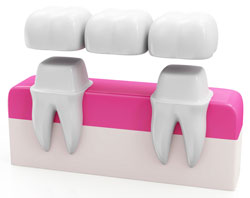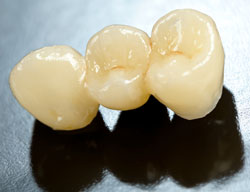Crowns and bridges are dental prostheses which are permanently attached to the tooth or teeth. 
Dental Crowns
Crowns are essentially a tooth capping, placed over the top of a tooth to restore its shape, function and appearance. Crowns may be needed to:
- Restore severely broken down, worn or heavily filled teeth
- Improve the appearance of irregularly shaped teeth
- help protect a tooth that is vulnerable to fracture
- restore a back tooth that has had root canal treatment
Dental Bridges
 Bridges can be used to replace a missing tooth or several missing teeth. If a gap is left empty, it’s not uncommon for teeth to shift and rotate into these spaces, resulting in misalignment and increased risk of gum disease and decay. The bridge itself consists of a false tooth (called a pontic) which is permanently attached to adjacent crowns.
Bridges can be used to replace a missing tooth or several missing teeth. If a gap is left empty, it’s not uncommon for teeth to shift and rotate into these spaces, resulting in misalignment and increased risk of gum disease and decay. The bridge itself consists of a false tooth (called a pontic) which is permanently attached to adjacent crowns.
An alternative to replacing a missing tooth with a bridge is to use a dental implant and crown.
Crown And Bridge Materials
There are a number of material options available for crowns and bridges. Each has its own benefits, and your dentist can recommend the best one for your needs.
Ceramic: Ceramic is a great option for people who wish to have metal-free restorations, or where the most natural-looking results are required. There are several different types of ceramics available, such as zirconia and e.max®.
Gold: Used in dentistry for centuries, gold is a very reliable and biocompatible material. Due to its colour, gold fillings are mostly used for the less-visible back teeth. The use of gold in dental crowns and bridges has been declining simply because people now prefer tooth coloured materials.
Metal-Ceramic: A metal-ceramic crown or bridge has a metal inner structure to which a ceramic outer layer is fused. This combination can produce strong, natural-looking restorations. At Preventive Dentistry, we prefer gold alloy as the inner metal due to its exceptional biocompatibility and superior fit.

Visit our case studies gallery to see before and after photos of what can be achieved with ceramic crowns.
The Dental Technician’s Laboratory
Producing a well-fitting, high-quality dental crown or bridge takes time, experience and advanced equipment. The most aesthetic and well-tailored dental prostheses are produced in a dedicated laboratory by a skilled dental technician and made precisely to specification.
We prefer using laboratory fabricated crowns rather than ‘single visit’ crowns made by a machine at the dental surgery.
In order to facilitate this, we use digital SLR cameras to record individual tooth characteristics in detail. In some cases, it is best for the patient to also visit the dental technician in person, and a digital shade matching scanner will be used to record precise colour gradients. This information lets the dental technician create the most optimally tailored dental crowns and bridges.
In order to ensure consistently high quality, Preventive Dentistry only entrusts our laboratory fabricated restorations to highly trained Australian dental technicians, with a demonstrable history of outstanding results. We will not send our work to cheaper overseas laboratories, which can be the case in some practices.
Contact Preventive Dentistry for appointments or more information on dental crowns and bridges.